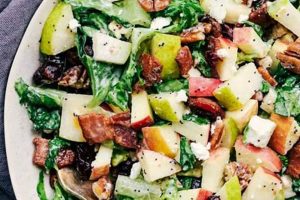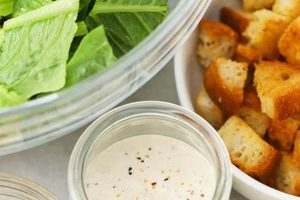A tangy, savory dressing typically composed of oil, vinegar, and seasonings, this emulsion often features a sweet element like sugar or honey, balanced by the sharpness of mustard. Common additions include chopped onion, dill, or parsley, contributing to a complex flavor profile that complements a variety of salads, particularly those with hearty greens, potatoes, or sausages.
This style of dressing offers a versatile and flavorful enhancement to simple salads, transforming them into more substantial and satisfying dishes. Its robust character holds up well against heavier ingredients, unlike more delicate vinaigrettes. The historical roots of this dressing likely lie in German culinary traditions, emphasizing practicality and resourcefulness, using readily available ingredients to create flavorful meals.
The following sections will explore variations on this classic dressing, providing detailed recipes and offering guidance on ingredient selection and preparation techniques. Further discussion will cover suitable salad pairings and suggestions for customizing the dressing to individual preferences.
Tips for Crafting a Superior Vinaigrette
Achieving a well-balanced and flavorful vinaigrette requires attention to detail and an understanding of the interplay between ingredients. These tips offer guidance for elevating a simple dressing into a culinary highlight.
Tip 1: Oil Selection Matters: A neutral oil like canola or grapeseed allows the other flavors to shine. For a more pronounced flavor, consider using extra virgin olive oil, but keep in mind its robust character can overpower delicate herbs.
Tip 2: Vinegar Variety: While white wine vinegar provides a classic tang, apple cider vinegar adds a subtle sweetness. Experimenting with different vinegars, such as red wine or sherry vinegar, can yield interesting flavor profiles.
Tip 3: Mustard as an Emulsifier: Mustard acts as a binding agent, helping the oil and vinegar blend into a stable emulsion. Stone-ground or Dijon mustard are excellent choices, contributing both flavor and texture.
Tip 4: Sweetness and Acidity Balance: A touch of sweetness, whether from sugar, honey, or maple syrup, balances the acidity of the vinegar. Adjust the amount according to personal preference and the other ingredients used.
Tip 5: Fresh Herbs Enhance Flavor: Freshly chopped herbs like dill, parsley, or chives add brightness and complexity. Add them just before serving to retain their vibrant flavor and aroma.
Tip 6: Seasoning is Crucial: Salt and freshly ground black pepper are essential for enhancing the overall flavor profile. Taste and adjust seasonings throughout the preparation process.
Tip 7: Proper Storage: Store leftover vinaigrette in an airtight container in the refrigerator for up to a week. Shake well before serving as the ingredients may separate over time.
By following these guidelines, one can create a vinaigrette that complements and enhances the flavors of any salad. Careful ingredient selection and attention to balance result in a dressing that is both flavorful and versatile.
The following section will offer several variations on the classic recipe, allowing for further exploration and customization.
1. Oil (e.g., canola, sunflower)
Oil forms the foundation of a German vinaigrette, influencing both flavor and texture. Selecting the appropriate oil is crucial for achieving the desired balance and enhancing the other ingredients. The type of oil chosen contributes significantly to the overall sensory experience of the vinaigrette.
- Flavor Profile
Neutral oils like canola and sunflower allow the other components, such as vinegar and herbs, to take center stage. Their mild flavor prevents the dressing from becoming too heavy or overpowering delicate salad ingredients. This characteristic makes them ideal for vinaigrettes intended for lighter salads with fresh greens or vegetables.
- Texture and Emulsification
The oil’s viscosity affects the emulsification process and the final texture of the vinaigrette. Canola and sunflower oils have a lighter texture, contributing to a smooth, pourable dressing. Their properties facilitate a stable emulsion with the vinegar, preventing separation and ensuring a consistent coating on the salad.
- Health Considerations
Canola and sunflower oils are often chosen for their perceived health benefits. They are typically lower in saturated fat and higher in unsaturated fats compared to some other oils. This nutritional aspect can be a factor when selecting an oil for a vinaigrette.
- Cost and Availability
Canola and sunflower oils are generally readily available and relatively affordable, making them practical choices for everyday use. Their accessibility contributes to the widespread use of these oils in various culinary applications, including German vinaigrettes.
The choice of oil in a German vinaigrette directly impacts the final taste and texture. While neutral oils like canola and sunflower offer a blank canvas for other flavors, they also contribute to a smooth, stable emulsion and offer practical advantages in terms of cost and availability. Careful consideration of these factors ensures a well-balanced and enjoyable dressing.
2. Vinegar (e.g., white wine, cider)
Vinegar provides the essential acidic component of a German vinaigrette, balancing the richness of the oil and contributing a sharp, tangy flavor. The specific type of vinegar selected significantly influences the dressing’s overall character. White wine vinegar, derived from fermented white wine, offers a crisp, clean acidity that complements delicate herbs and vegetables. Cider vinegar, made from fermented apple juice, imparts a slightly sweeter, fruitier note, adding depth and complexity to the vinaigrette. The choice between these vinegars, or the incorporation of other varieties like red wine or sherry vinegar, allows for customization and nuanced flavor profiles.
The interaction between vinegar and other ingredients is crucial. For example, a higher proportion of vinegar relative to oil creates a more tart dressing, suitable for robust greens or salads featuring ingredients like potatoes or cured meats. Conversely, a lower vinegar concentration yields a milder vinaigrette, ideal for delicate lettuces or fresh vegetable salads. The sweetness of certain vinegars, like cider vinegar, can also influence the need for additional sweeteners in the recipe. Understanding these interactions allows for precise control over the final flavor profile, ensuring the vinaigrette complements the other salad components harmoniously.
Selecting the appropriate vinegar is essential for achieving a balanced and flavorful German vinaigrette. The vinegar’s acidity not only provides a counterpoint to the oil but also interacts with other ingredients, influencing the overall taste. Careful consideration of these factors allows for the creation of a dressing that enhances the salad, rather than overpowering it. Experimentation with different vinegar types offers further opportunities to customize the vinaigrette and create unique flavor combinations.
3. Sweetener (e.g., sugar, honey)
Sweetener plays a crucial role in a German vinaigrette, balancing the acidity of the vinegar and contributing to the overall complexity of the dressing. The judicious use of sweeteners like sugar or honey rounds out the sharpness of the vinegar, preventing the vinaigrette from tasting overly tart. This balance is essential for creating a harmonious flavor profile that complements the other salad ingredients. The type of sweetener chosen can also subtly influence the final taste. Granulated sugar provides a clean, neutral sweetness, while honey adds floral notes and a richer texture. Other options, such as maple syrup or agave nectar, offer distinct flavor profiles that can further customize the vinaigrette.
The amount of sweetener used depends on the specific vinegar and other ingredients. A more acidic vinegar, like white wine vinegar, might require a higher proportion of sweetener compared to a milder vinegar like apple cider vinegar. Similarly, the presence of other sweet elements in the salad, such as dried cranberries or candied nuts, might necessitate a reduction in added sweetener within the vinaigrette. Achieving the correct balance is key: insufficient sweetener results in an overly sharp dressing, while excessive sweetness can mask the other flavors. A classic German potato salad, for example, often benefits from a slightly sweeter vinaigrette to complement the earthy potatoes and tangy pickles, whereas a delicate green salad might require a less sweet dressing to avoid overpowering the fresh flavors of the greens.
Careful consideration of sweetener type and quantity is essential for crafting a well-balanced German vinaigrette. The sweetener’s primary function is to temper the vinegar’s acidity, but it also contributes to the overall complexity and depth of flavor. Understanding the interplay between sweetener, vinegar, and other salad components allows for precise control over the final taste, ensuring the vinaigrette enhances, rather than overwhelms, the other flavors.
4. Mustard (e.g., Dijon, stone-ground)
Mustard serves a multifaceted role in a German vinaigrette, contributing not only to flavor but also to texture and emulsification. Its presence is integral to the dressing’s overall character and stability. Understanding the different types of mustard and their specific contributions is essential for crafting a successful vinaigrette.
- Emulsification and Texture
Mustard acts as an emulsifier, helping to bind the oil and vinegar together, creating a stable and homogenous mixture. This prevents the dressing from separating and ensures a consistent coating on the salad. The mustard’s texture also contributes to the overall mouthfeel of the vinaigrette, adding a subtle creaminess.
- Flavor Complexity
Mustard’s sharp, pungent flavor adds depth and complexity to the vinaigrette. Dijon mustard, with its smooth texture and pronounced tang, provides a classic flavor profile. Stone-ground mustard, characterized by its coarser texture and more robust flavor, offers a more rustic character. The choice of mustard significantly influences the final taste of the dressing.
- Balancing Acidity
The slight bitterness and pungency of mustard can help balance the acidity of the vinegar, contributing to a more rounded and harmonious flavor profile. This interplay between mustard and vinegar is crucial for achieving a well-balanced vinaigrette.
- Complementary Flavors
Mustard’s flavor profile complements many traditional German salad ingredients, such as potatoes, sausages, and hearty greens. The sharpness of the mustard enhances the earthy flavors of these components, creating a cohesive and satisfying culinary experience.
The selection and incorporation of mustard represent a crucial step in creating a successful German vinaigrette. Its impact extends beyond flavor, influencing texture, stability, and the overall balance of the dressing. The choice between Dijon, stone-ground, or other mustard varieties allows for customization and the creation of unique flavor profiles suited to various salad combinations. The interplay between mustard and the other ingredients contributes significantly to the final character of the vinaigrette, highlighting the importance of this seemingly simple component.
5. Seasoning (salt, pepper)
Seasoning, primarily with salt and pepper, forms an indispensable component of a German vinaigrette salad dressing recipe. Salt’s function extends beyond simply adding a salty taste; it enhances the perception of other flavors within the dressing, amplifying the sweetness and acidity while tempering any bitterness. Furthermore, salt plays a crucial role in the structural integrity of the vinaigrette, influencing the solubility and interaction of other ingredients, thereby contributing to a stable emulsion. Pepper, particularly freshly ground black pepper, introduces complexity with its subtle heat and aromatic notes, adding depth to the overall flavor profile. The synergistic interplay between salt and pepper elevates the vinaigrette, transforming it from a simple mixture of ingredients into a balanced, flavorful dressing.
Consider a classic German potato salad dressed with a vinaigrette. The salt not only enhances the inherent flavors of the potatoes but also amplifies the tanginess of the vinegar and the sweetness of any added sugar or onion. The freshly ground pepper adds a subtle warmth that complements the earthy potatoes and other ingredients like pickles or celery. Without proper seasoning, the vinaigrette, and consequently the entire salad, would lack depth and complexity, resulting in a bland and unappetizing dish. Achieving the correct balance of salt and pepper is crucial; insufficient seasoning results in a flat, uninteresting flavor, while over-seasoning can overwhelm the other delicate components of the salad.
Effective seasoning requires careful consideration and adjustment based on the specific ingredients used in both the vinaigrette and the salad itself. A vinaigrette intended for a robust salad with hearty greens or cured meats may necessitate a bolder seasoning approach compared to one designed for a delicate green salad with fresh herbs. Furthermore, the saltiness of certain ingredients, like olives or capers, within the salad must be considered when seasoning the vinaigrette. Mastering the art of seasoning with salt and pepper is paramount to creating a balanced and flavorful German vinaigrette salad dressing, ultimately transforming a simple salad into a truly satisfying culinary experience.
6. Aromatics (e.g., onion, garlic)
Aromatics, such as onion and garlic, contribute significantly to the complexity and depth of flavor in a German vinaigrette salad dressing. These pungent ingredients, when used judiciously, elevate the dressing beyond a simple mixture of oil and vinegar, adding layers of savory notes that complement various salad components. Their careful integration into the vinaigrette enhances the overall sensory experience, creating a more nuanced and satisfying culinary experience.
- Flavor Enhancement
Aromatics impart distinct flavors that enhance the overall profile of the vinaigrette. Onion, whether finely chopped or grated, contributes a sharp, slightly sweet note, while garlic adds a pungent, savory depth. These flavors meld with the other ingredients, creating a more complex and balanced taste.
- Balancing Acidity and Richness
The sharp notes of onion and garlic can help balance the acidity of the vinegar and the richness of the oil in the vinaigrette. This interplay of flavors prevents the dressing from being overly tart or heavy, resulting in a more harmonious and palatable experience.
- Aromatic Complexity
Beyond their flavor contributions, aromatics also offer aromatic complexity to the vinaigrette. The volatile compounds released by onion and garlic, particularly when macerated in the dressing, add another dimension to the sensory experience. These aromas stimulate the appetite and enhance the overall enjoyment of the salad.
- Complementary Pairings
The flavors of onion and garlic complement a wide range of traditional German salad ingredients. Their pungent notes pair well with hearty greens, potatoes, sausages, and cheeses, creating a cohesive and flavorful dish. For example, the sharpness of raw onion complements the richness of a German potato salad, while the subtle pungency of garlic enhances the flavors of a mixed green salad with bacon.
The strategic use of aromatics like onion and garlic is essential for creating a truly authentic and flavorful German vinaigrette. Their contribution extends beyond mere flavor enhancement, impacting the balance, aroma, and overall complexity of the dressing. The careful consideration of these aromatic elements elevates the vinaigrette from a simple condiment to an integral component of the salad, enriching the culinary experience and showcasing the depth of flavor achievable through thoughtful ingredient selection.
7. Herbs (e.g., dill, parsley)
Fresh herbs constitute a defining element in German vinaigrette, contributing a bright, aromatic dimension that elevates the dressing beyond a simple emulsion of oil and vinegar. Their presence not only enhances the flavor profile but also adds a visual appeal, signifying freshness and culinary finesse. The careful selection and incorporation of herbs like dill and parsley are essential for achieving an authentic and flavorful German vinaigrette.
- Flavor Enhancement
Fresh herbs contribute distinct aromatic and flavor notes that complement the other components of the vinaigrette. Dill, with its slightly anise-like flavor, adds a refreshing, herbaceous element, while parsley provides a clean, peppery taste. These herbal notes enhance the overall complexity of the dressing, preventing it from tasting flat or one-dimensional.
- Balancing Richness and Acidity
The bright, fresh flavors of herbs can help balance the richness of the oil and the acidity of the vinegar in the vinaigrette. This balancing act creates a more harmonious flavor profile, preventing the dressing from being overly heavy or tart. The herbs’ inherent lightness complements the other ingredients, resulting in a well-rounded and refreshing taste.
- Visual Appeal and Freshness
The vibrant green color of fresh herbs adds visual appeal to the vinaigrette, enhancing the overall presentation of the salad. The visual cue of fresh herbs also signifies freshness and quality, contributing to a more appealing sensory experience. This visual element is particularly important in salads, where aesthetics play a significant role in enjoyment.
- Traditional German Cuisine
The use of dill and parsley in vinaigrettes aligns with traditional German culinary practices, where these herbs feature prominently in various dishes. Their inclusion in a vinaigrette provides an authentic touch, reflecting the culinary heritage associated with German cuisine. This connection to tradition further enhances the overall dining experience.
The incorporation of fresh herbs like dill and parsley represents a crucial step in crafting an authentic and flavorful German vinaigrette. Their contribution extends beyond mere flavor enhancement, influencing the balance, visual appeal, and cultural significance of the dressing. The careful selection and integration of these herbal elements elevate the vinaigrette, demonstrating an attention to detail and a respect for traditional German culinary practices. This thoughtful approach results in a dressing that not only complements the salad but also enriches the overall dining experience.
Frequently Asked Questions
This section addresses common inquiries regarding German vinaigrette salad dressing, offering concise and informative responses to clarify potential uncertainties and misconceptions.
Question 1: What distinguishes a German vinaigrette from other vinaigrettes?
German vinaigrettes typically feature a balance of sweet and tangy flavors, often incorporating sugar or honey alongside a sharp vinegar. The inclusion of mustard as an emulsifier and the frequent use of dill and onion further distinguish this style.
Question 2: Can olive oil be used in a German vinaigrette?
While neutral oils like canola or sunflower are traditional, extra virgin olive oil can be used. However, its robust flavor should be carefully considered, potentially requiring adjustments to other ingredients to maintain balance.
Question 3: How long can a prepared German vinaigrette be stored?
Stored in an airtight container in the refrigerator, a German vinaigrette can typically last for up to one week. Separation may occur; shaking well before use restores the emulsion.
Question 4: What salads pair well with a German vinaigrette?
Hearty salads featuring potatoes, sausages, or robust greens, such as kale or arugula, pair particularly well with German vinaigrettes. The dressing’s robust flavor profile complements these ingredients effectively.
Question 5: Can the sweetness level of a German vinaigrette be adjusted?
The amount of sugar or honey can be adjusted to suit individual preferences. Start with a smaller amount and gradually increase until the desired sweetness is achieved, ensuring balance with the vinegar’s acidity.
Question 6: What can be substituted for dill if it’s unavailable?
While dill provides a characteristic flavor, fresh parsley or chives can serve as suitable substitutes in a German vinaigrette. These herbs offer a similar fresh, herbaceous element, albeit with distinct flavor profiles.
Understanding these common points of inquiry provides a foundation for crafting and utilizing a German vinaigrette effectively, ensuring a flavorful and satisfying culinary experience.
The following section provides a selection of recipe variations for further exploration.
German Vinaigrette Salad Dressing Recipe
This exploration of German vinaigrette salad dressing recipes has highlighted the essential components and techniques that contribute to its distinctive character. From the selection of oils and vinegars to the nuanced use of sweeteners, mustards, and aromatics, each ingredient plays a crucial role in the final flavor profile. The balance between sweet and tangy elements, combined with the aromatic contributions of fresh herbs, defines this classic dressing, making it a versatile accompaniment to a variety of salads, particularly those featuring hearty ingredients like potatoes, sausages, and robust greens. An understanding of these core elements empowers culinary enthusiasts to create flavorful and authentic German vinaigrettes.
The adaptability of this dressing allows for further exploration and customization. Experimentation with different oils, vinegars, and herbs offers opportunities to create unique flavor profiles tailored to individual preferences and specific salad combinations. This enduring culinary tradition provides a foundation for continued exploration and innovation, ensuring that the German vinaigrette remains a vibrant and versatile element within the broader culinary landscape.






